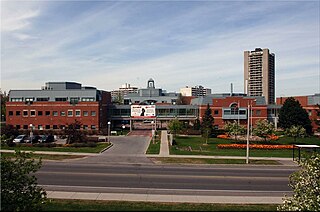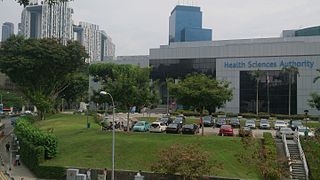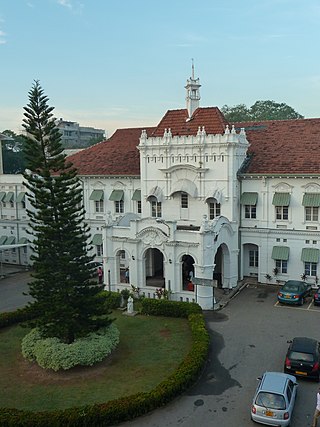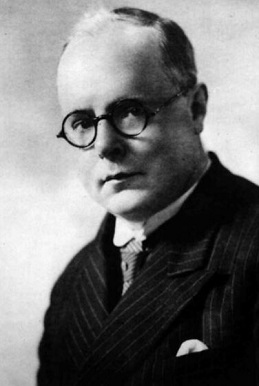Related Research Articles

Blood transfusion is the process of transferring blood products into a person's circulation intravenously. Transfusions are used for various medical conditions to replace lost components of the blood. Early transfusions used whole blood, but modern medical practice commonly uses only components of the blood, such as red blood cells, plasma, platelets, and other clotting factors. White blood cells are transfused only in very rare circumstances, since granulocyte transfusion has limited applications. Whole blood has come back into use in the setting of trauma.

A blood donation occurs when a person voluntarily has blood drawn and used for transfusions and/or made into biopharmaceutical medications by a process called fractionation. Donation may be of whole blood, or of specific components directly (apheresis). Blood banks often participate in the collection process as well as the procedures that follow it.

Canadian Blood Services is a non-profit charitable organization that is independent from the Canadian government. The Canadian Blood Services was established as Canada's blood authority in all provinces and territories except for Quebec in 1998. The federal, provincial and territorial governments created the Canadian Blood Services through a memorandum of understanding. Canadian Blood Services is funded mainly through the provincial and territorial governments.

In England, blood and other tissues are collected by NHS Blood and Transplant (NHSBT). NHSBT Blood Donation was previously known as the National Blood Service until it merged with UK Transplant in 2005 to form a NHS special health authority. Other official blood services in the United Kingdom include the Northern Ireland Blood Transfusion Service, the Scottish National Blood Transfusion Service and the Welsh Blood Service.
The Irish Blood Transfusion Service (IBTS), or Seirbhís Fuilaistriúcháin na hÉireann in Irish, was established in Ireland as the Blood Transfusion Service Board (BTSB) by the Blood Transfusion Service Board (Establishment) Order, 1965. It took its current name in April 2000 by Statutory Instrument issued by the Minister for Health and Children to whom it is responsible. The Service provides blood and blood products for humans.
NHS Blood and Transplant is an executive special health authority of the United Kingdom's Department of Health and Social Care. It was established on 1 October 2005 to take over the responsibilities of two separate NHS agencies: UK Transplant, founded by Dr. Geoffrey Tovey in 1972, and the National Blood Service. Its remit is to provide a reliable, efficient supply of blood, organs and associated services to the NHS. Since NHSBT was established, the organisation has maintained or improved the quality of the services delivered to patients, stabilised the rising cost of blood, and centralised a number of corporate services.

The Health Sciences Authority (HSA) is a statutory board under the Ministry of Health of the Government of Singapore. It is a multi-disciplinary agency responsible for applying medical, pharmaceutical, and scientific expertise to protect and advance public health and safety.

The Scottish National Blood Transfusion Service (SNBTS) is the national blood, blood product and tissue provider. It makes up a Strategic Business Unit of NHS National Services Scotland (NSS).
The New Zealand Blood Service is the provider of blood services for New Zealand. The service is a Crown entity responsible to New Zealand's Parliament and is governed by a Board appointed by the Minister of Health.

World Blood Donor Day (WBDD) is held on June 14 each year. The event was organised for the first time in 2004, by four core international organizations: the World Health Organization, the International Federation of Red Cross and Red Crescent Societies; the International Federation of Blood Donor Organizations (IFBDO) and the International Society of Blood Transfusion (ISBT) to raise awareness of the need for safe blood and blood products, and to thank blood donors for their voluntary, life-saving gifts of blood. World Blood Donor Day is one of 11 official global public health campaigns marked by the World Health Organization (WHO), along with World Health Day, World Chagas Disease Day, World Tuberculosis Day, World Immunization Week, World Patient Safety Day, World Malaria Day, World No Tobacco Day, World Hepatitis Day, World Antimicrobial Awareness Week and World AIDS Day.
The South African National Blood Service (SANBS) is a non-profit organisation that provides human blood for transfusion that operates in South Africa, with the exception of the Western Cape, which has its own blood service. The head office of the SANBS is in Constantia Kloof, Gauteng, near Johannesburg, but there are blood collection operations in eight of the nine provinces. Western Cape has a separate blood centre, the Western Cape Blood Service. SANBS was founded in 2001 from a merger of seven blood centres, and was embroiled in controversy in 2004 over a policy of racial profiling for blood safety.
Blood donation in Bangladesh is an activity conducted by several different organisations. As of 2011, about 25% of the nation's blood supply came from voluntary donation, 20–25% from paid donors, and 50–55% from one-time donation for a specific patient.

Sankalp India Foundations is a Bangalore-based non-government organisation. It is a youth organisation working for blood donation, thalassemia, bone marrow transplantation and disaster relief.
The Welsh Blood Service is a division of Velindre University NHS Trust responsible for the collection of blood in Wales, and of the distribution of blood products to hospitals within the country, as well as other related functions.
Frederic Duran i Jordà was a Spanish medical doctor, pioneer hematology and hemotherapy. He created the first transfusion service in the world in Barcelona in 1936 at the beginning of the Spanish Civil War. Previously there were blood banks, where donated blood to be transfused was stored. Dr. Duran i Jordà created a methodology that would serve to collect massive blood donations and be transfused distance, in this case the front lines of the Spanish Civil War. This method was subsequently applied in World War II.
Fereydoun Ala is an Iranian physician and academician, specialised in internal medicine, haematology, blood transfusion and haemostasis, who established the first Clinical Haematology Department, and the first Haemophilia Centre in Iran at the Tehran University Medical Faculty. He was the founder of the Iranian National Blood Transfusion Service (INBTS), a centralised, state-funded organisation, established in 1974, for the recruitment of healthy, voluntary, non-remunerated blood donors.

The National Hospital of Sri Lanka is a government hospital in Colombo, Sri Lanka. Founded in 1864 as the General Hospital, it is the leading hospital in Sri Lanka and is controlled by the central government. The hospital has 18 intensive care units and 21 operating theaters and 3,404 beds. It employs 7,500 staff of which 1,500 are doctors. The hospital carries out 5,000 major and minor surgeries each month and treats over two million out patients a year. Situated on a 36-acre site, it includes the Dental Institute, Maligawatte Kidney Hospital, Nurse's Training School, Post Basic Nurse's Training School, School of Eco Cardiograph, School of Physiotherapy, School of Radiography and the University of Colombo's Faculty of Medicine.
Blood donations in India are conducted by organisations and hospitals through blood donation camps. Donors can also visit blood banks in hospitals to donate blood. Efforts by the government and advocacy groups over the years have helped bridge the gap between demand and supply. The regulatory framework for blood donation and blood bank management rests with the Central Drugs Standard Control Organisation, while technical bodies like the National Blood Transfusion Council and National AIDS Control Organisation formulate guidelines and recommendations for transfusion medicine and blood bank management. Challenges persist with regards to regulation of blood banks and transfusion practices as the sector is largely fragmented with uneven distribution of blood banks and supply of blood in parts of the country. Donors are usually provided with refreshments after the procedure, which include glucose drinks, biscuits and fruits. Some organisations offer transportation facilities, as well as certificates or badges as gratitude.

Percy Lane Oliver was a British civil servant, who is credited with founding the first volunteer blood donation service. A layman, Oliver was working for the Camberwell division of the Red Cross in 1921 when he responded to a call from a local hospital requesting an urgent blood donation. This experience led him to organise a panel of donors whose blood types were known and who were available to donate on request. The donors, unusually for the time, were not paid. Oliver's blood donation service, which he ran out of his London home, would grow from 20 volunteers at its inception to approximately 2700 in 1938. His model of voluntary blood donation was adopted throughout Britain and in other countries.
The Irish Haemophilia Society (IHS) is an organization that represents the interests of people with haemophilia, von Willebrand disease and other inherited bleeding disorders.
References
- 1 2 3 4 5 6 7 8 9 10 11 12 "History of Blood Transfusion Service in Sri Lanka". National Blood Transfusion Service of Sri Lanka via Wayback Machine. 2010. Archived from the original on November 18, 2012. Retrieved 21 March 2015.
- 1 2 "Homepage". NBTS. 2014. Archived from the original on 5 February 2014. Retrieved 11 February 2014.
- ↑ "Opening of Anura B ward and blood bank". TheIsland.lk. 11 March 2012. Retrieved 17 April 2013.
- ↑ "World Blood Donor Day 2014". NBTS. 2014. Archived from the original on 30 October 2014. Retrieved 30 October 2014.